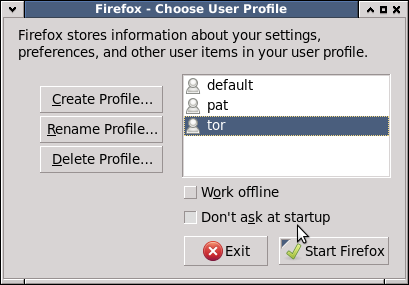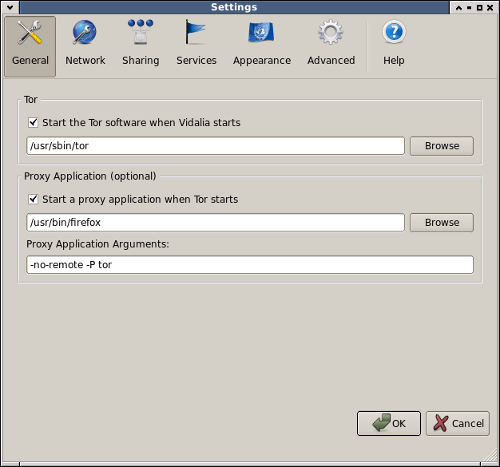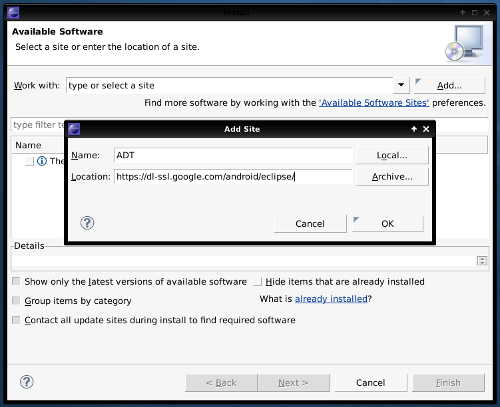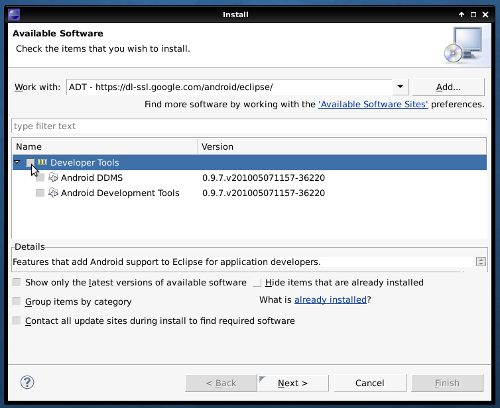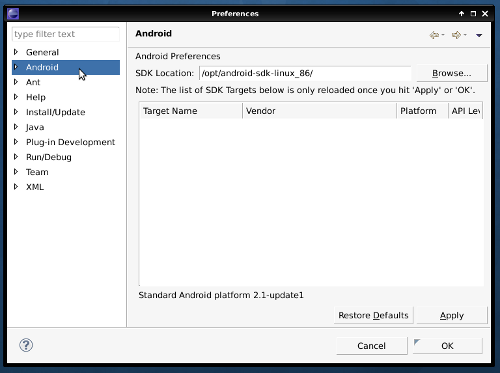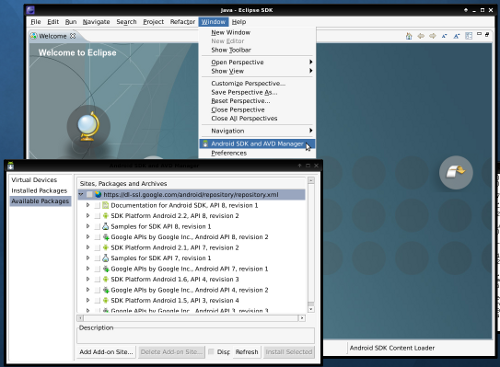I have installed this setup some time ago on my system and wrote down the steps. To validate that every step is still correct I used VirtualBox and installed the system again.
At the end of this howto, you will have a full working gentoo system with (nearly) full disk encryption, coded RAM and an easily expandable disk partition schema. Full disk encryption under GNU/Linux isn’t possible like it is with e.g. Truecrypt under Windows. So in most cases you will have to leave your /boot partition unencrypted or use a removable medium like an usb stick to boot your system. In this setup we will leave /boot as it is.
What you need:
- Backup of your running system since your disks will be erased
- Linux compatible hardware
- Internet connection
- Some time
- Experience with the GNU/Linux system is highly recommended
- A GNU/Linux system (Live CD, usb stick, installation on other disk etc.) This howto uses the Gentoo Weekly Minimal Install CD for amd64
Although I will try, explaining every step in detail would be to much for this howto so I have to point you to Google and the Gentoo Handbook.
1. Preparing the installation
Use for example UNetbootin to create a bootable usb stick or just burn the cd. When you’re using GRUB2 on your system, you can boot the iso file directly through grub’s loopback ability. Change your BIOS settings accordingly.
2. Booting and choosing the correct keyboard layout
Boot the installation system and choose the default kernel at prompt. When all kernel modules are loaded you have the opportunity to change the keyboard layout to your needs (for german layout, type de or 10).
3. Configuring your network
Find out how your network adapters are called with ifconfig -a. To obtain an IP for the wired network link on eth0, type dhcpd eth0. To show your IP just type ifconfig eth0 and look for inet addr. To continue the installation from another computer, start the sshd server with /etc/init.d/sshd start, set a password for root with the passwd command and connect from the other computer with ssh root@IP under Linux or use Putty under Windows.
4. Preparing your harddisk(s)
At this point you have more then one possibility on how to create your disk layout, so you should be really sure what you want. If you are not sure or don’t know how to split your disk, check out the handbook again and/or search Google. You have to decide in which order your different layers occur. It is possible to create one big (physical) LVM partition, configure the logical volumes and encrypt these individually. You can also create a standard partition, encrypt the whole partition and configure your logical volumes inside your secure container. Both setups have advantages and disadvantages. The first makes it quite easy to change your LVM layout and you can different passwords for every mount point if you like. The second method has the advantage that other systems will only see one big encrypted partition and nothing else and you only need one password to decrypt the system (although this is also possible with the first setup).
In this setup we will create a small partition for /boot, a separate partition for swap and another one for the physical LVM. Maybe I will add one or two alternatives to this guide in the future, but for now I am going with the first method as I think it is the more difficult one to reproduce. Use fdisk or cfdisk to configure the harddisk(s) to your needs.
The partition table I chose for this howto
livecd ~ # fdisk -l /dev/sda
Disk /dev/sda: 21.5 GB, 21474836480 bytes
255 heads, 63 sectors/track, 2610 cylinders
Units = cylinders of 16065 * 512 = 8225280 bytes
Disk identifier: 0x00000000
Device Boot Start End Blocks Id System
/dev/sda1 * 1 61 489951 83 Linux
/dev/sda2 62 183 979965 82 Linux swap / Solaris
/dev/sda3 184 2007 14651280 8e Linux LVM
5. Loading the necessary kernel modules
You need to load the necessary kernel modules for your algorithm and cipher. Use google to learn more about algorithms and ciphers.
livecd ~ # modprobe dm-mod dm-crypt sha256
6. Create and activate the LVM Setup
First we need to create the physical volume on /dev/sda3 and a volume group called vg1 with
livecd ~ # pvcreate /dev/sda3
livecd ~ # vgcreate vg1 /dev/sda3
Next we use lvcreate to create the individual logical volumes. This step is similar to the standard partitioning process, however, since we are creating logical volumes here, it is possible to change their size later again. The chosen layout here is just a demonstration of the general functionality. The name defined with the -n flag (-L is size) is just for you, so the name doesn’t have to match the later mountpoint.
livecd ~ # lvcreate -L7G -nroot vg1
livecd ~ # lvcreate -L3G -ntmp vg1
livecd ~ # lvcreate -L3G -nhome vg1
You can use the vgdisplay or vgs command to see the remaining disk space. Check your result with lvscan.
livecd ~ # lvscan
ACTIVE ‚/dev/vg1/root‘ [7.00 GiB] inherit
ACTIVE ‚/dev/vg1/tmp‘ [3.00 GiB] inherit
ACTIVE ‚/dev/vg1/home‘ [3.00 GiB] inherit
HINT:If you need to reboot, you can reactivate the LVM setup with lvchange -a y vg1 .
7. Encrypting
Next step is to encrypt the freshly generated volumes using this short loop (easily expandable if you want to create more containers).
livecd ~ # for i in root tmp home
> do
> cryptsetup -c aes-cbc-essiv:sha256 -s 256 luksFormat /dev/vg1/$i
> done
Confirm with YES and type in your password twice per volume.
Also encrypt the swap partition during the setup process.
livecd ~ # cryptsetup create -c aes-cbc-essiv:sha256 -s 256 -d /dev/urandom swap /dev/sda2
livecd ~ # mkswap /dev/mapper/swap
livecd ~ # swapon /dev/mapper/swap
8. Open the containers and format with a filesystem
Next we open our containers and create a filesystem. The choice of the filesystem depends on your needs, see google or the gentoo handbook.
livecd ~ # for i in root tmp home
> do
> cryptsetup luksOpen /dev/vg1/$i crypt$i
> done
Put in the password for every volume.
livecd ~ # for i in root tmp home
> do
> mkfs.ext4 /dev/mapper/crypt$i
> done
livecd ~ # mkfs.ext2 /dev/sda1
Don’t forget to format the boot partition as well.
9. Create the mountpoints and mount your volumes
livecd ~ # mount /dev/mapper/cryptroot /mnt/gentoo/
livecd ~ # for i in boot tmp home
> do
> mkdir /mnt/gentoo/$i
> done
livecd ~ # mount /dev/sda1 /mnt/gentoo/boot/
livecd ~ # for i in tmp home
> do
> mount /dev/mapper/crypt$i /mnt/gentoo/$i
> done
10. Preparing the chroot
Before chrooting into the new installation directory we have to prepare a few things, e.g. setting the correct file permissions before changing the directory
livecd ~ # chmod 1777 /mnt/gentoo/tmp/
livecd ~ # cd /mnt/gentoo/
and setting the correct date.
livecd gentoo # date MMDDhhmmYYYY
Next download the needed installation files. Select the best mirror near you and download (press d in links) the latest stage3 and portage files as well as the .CONTENTS .DIGESTS and .md5sum files using links.
livecd gentoo # links http://www.gentoo.org/main/en/mirrors.xml
Latest stage3 file can be found under /releases/amd64/current-stage3/ (select the right folder for your architecture) and the latest can be found using the symlink in /snapshots/portage-latest.tar.bz2.
Verify your downloads with md5sum and extract them when there is no error.
livecd gentoo # md5sum -c stage3-amd64-20100617.tar.bz2.DIGESTS
livecd gentoo # md5sum -c portage-latest.tar.bz2.md5sum
livecd gentoo # tar xvjpf stage3-amd64-20100617.tar.bz2
livecd gentoo # tar xvjf /mnt/gentoo/portage-latest.tar.bz2 -C /mnt/gentoo/usr
Take a look at the wiki entry about CFLAGS and edit the make.conf to your needs. I use the Amd Athlon 64 64bit settings here.
livecd gentoo # nano /mnt/gentoo/etc/make.conf
CHOST=“x86_64-pc-linux-gnu“
CFLAGS=“-march=k8 -O2 -pipe“
CXXFLAGS=“${CFLAGS}“
Select the nearest mirror
livecd gentoo # mirrorselect -i -o >> /mnt/gentoo/etc/make.conf
livecd gentoo # mirrorselect -i -r -o >> /mnt/gentoo/etc/make.conf
Copy the DNS information to your chroot and mount the needed devices
livecd gentoo # cp -L /etc/resolv.conf /mnt/gentoo/etc/
livecd gentoo # mount -t proc none /mnt/gentoo/proc
livecd gentoo # mount -o bind /dev /mnt/gentoo/dev
11. Chroot into your new environment
Change into your new root and sync and update your system.
livecd gentoo # chroot /mnt/gentoo/ /bin/bash
livecd / # env-update && source /etc/profile
livecd / # emerge –sync
12. Select a profile
Select the right profile for you using eselect
livecd / # eselect profile list
Available profile symlink targets:
[1] default/linux/amd64/10.0 *
[2] default/linux/amd64/10.0/desktop
[3] default/linux/amd64/10.0/desktop/gnome
[4] default/linux/amd64/10.0/desktop/kde
[5] default/linux/amd64/10.0/developer
[6] default/linux/amd64/10.0/no-multilib
[7] default/linux/amd64/10.0/server
[8] hardened/linux/amd64/10.0
[9] hardened/linux/amd64/10.0/no-multilib
[10] selinux/2007.0/amd64
[11] selinux/2007.0/amd64/hardened
[12] selinux/v2refpolicy/amd64
[13] selinux/v2refpolicy/amd64/desktop
[14] selinux/v2refpolicy/amd64/developer
[15] selinux/v2refpolicy/amd64/hardened
[16] selinux/v2refpolicy/amd64/server
livecd / # eselect profile set 2
13. Adjust make.conf
Adjust the make.conf file to your needs and set the needed USE flags, languages and devices
livecd / # nano /etc/make.conf
MAKEOPTS=“-j2″
USE=“3dnow 3dnowext a52 aac acl acpi alsa -amd64 apache2 -avahi
avi bluetooth -beagle cairo cdb cddb cdparanoia cdr cli cracklib
crypt css -cups daap dbus dga directfb dri dts dvb dvd dvdr dvdread -eds
-emboss encode -esd -evo exif fam ffmpeg flac ftp gdbm gif -gnome gstreamer gtk
hal -ipv6 -isdnlog -joystick -kde libnotify lirc lm_sensors mad mmx mmxext mp3
mpeg mysql ncurses nls ogg opengl pdf png -ppds -pppd qt3 qt3support quicktime samba sdl sse sse2
ssl svg tiff transcode unicode usb v4l vcd vorbis wma
X x264 xcomposite xine xml xorg xv xvid xvmc zlib“
LINGUAS=“de en“
INPUT_DEVICES=“keyboard mouse“
VIDEO_CARDS=“vesa“
14. Configure your charsets
Define (uncomment) and generate the needed charsets incl. UTF-8 (german)
livecd / # nano /etc/locale.gen
en_US ISO-8859-1
en_US.UTF-8 UTF-8
de_DE ISO-8859-1
de_DE@euro ISO-8859-15
de_DE.UTF-8 UTF-8
livecd / # locale-gen
15. Setting the timezone
Find the right timezone for you and copy it
livecd / # ls /usr/share/zoneinfo/
livecd / # cp /usr/share/zoneinfo/Europe/Berlin /etc/localtime
16. Installation of kernel sources and other needed pakets
Install the kernel sources and other pakets that are needed for your setup
livecd / # emerge -av gentoo-sources
livecd / # emerge -av genkernel cryptsetup lvm2
17. Compile your own kernel
The next step is one of the most important. Take care that you include everything in your kernel that you need for your hardware to work. Use genkernel to make life a little bit easier.
livecd / # cd /usr/src/linux
livecd linux # genkernel –no-clean –menuconfig –save-config –luks –lvm all
You can use the kernel configuration of the gentoo live cd as a basis for your own configuration. Just copy the config file before running genkernel.
livecd linux # zcat /proc/config.gz > /usr/share/genkernel/arch/x86_64/kernel-config
The most important kernel options for this guide to add. You might need others depending on the chosen cipher etc. Don’t forget to enable Ext4 support if you need it.
Device Drivers —>
Multi-device support (RAID and LVM) —>
[*] Multiple devices driver support (RAID and LVM)
< > RAID support
<*> Device mapper support
<*> Crypt target support
File Systems —>
<*> The Extended 4 (ext4) filesystem
Cryptographic API —>
<*> SHA256 digest algorithm
<*> AES cipher algorithms
I found a few postings on the net saying, that genkernel needs a valid /etc/fstab to build a correct initramfs. Do step 19 first to be 100% safe.
18. Kernel Modules
List the compiled kernel modules with
livecd linux # find /lib/modules/<kernel version>/ -type f -iname ‚*.o‘ -or -iname ‚*.ko‘ | less
and add them to your /etc/modules.autoload.d/kernel-2.6.
19. Edit the /etc/fstab
# <fs> <mountpoint> <type> <opts> <dump/pass>
/dev/sda1 /boot ext2 noauto,noatime 1 2
/dev/mapper/swap none swap sw 0 0
/dev/mapper/cryptroot / ext4 noatime 0 0
/dev/mapper/crypthome /home ext4 noatime 0 1
/dev/mapper/crypttmp /tmp ext4 noatime 0 2
/dev/cdrom /mnt/cdrom auto noauto,ro 0 0
shm /dev/shm tmpfs nodev,nosuid,noexec 0 0
20. Basic system configuration
Setting a hostname
livecd / # nano /etc/conf.d/hostname
Setting the root password. Important: This password is inside your chroot and for your future system, the password you set at the beginning was just needed for ssh access to the box! If you don’t set it, you won’t be able to login.
livecd / # passwd
System information like default editor or windows manager
livecd / # nano /etc/rc.conf
Change the keymap and timezone
livecd / # nano /etc/conf.d/keymaps
KEYMAP=“de“
Setting the clock
livecd / # nano /etc/conf.d/clock
TIMEZONE=“Europe/Berlin“
Installing some system tools (logger, filesystem tools etc.)
livecd / # emerge -av syslog-ng logrotate pciutils gentoolkit
Start the system logger at boot
livecd / # rc-update add syslog-ng default
Networking: Installing a dhcp client
livecd / # emerge -av dhcp
21. Installing the bootloader GRUB
Another really important part is the installation of a bootloader. Take care that you use the correct devices, partitions and paths – double check! If you want or need the features of GRUB 2 take a look at this page.
livecd / # emerge -av grub
Now you need to find out the exact file names for your kernel and initramfs and edit /boot/grub/grub.conf accordingly.
livecd / # ls /boot/initramfs* /boot/kernel*
-rw-r–r– 1 root root 1814297 Jul 24 00:14 /boot/initramfs-genkernel-x86_64-2.6.34-gentoo-r1
-rw-r–r– 1 root root 4261424 Jul 24 00:13 /boot/kernel-genkernel-x86_64-2.6.34-gentoo-r1
livecd / # nano /boot/grub/grub.conf
title Gentoo Linux 2.6.34-r1
root (hd0,0)
kernel /boot/kernel-genkernel-x86_64-2.6.34-gentoo-r1 root=/dev/ram0 crypt_root=/dev/vg1/root init=/linuxrc splash=silent dolvm
initrd /boot/initramfs-genkernel-x86_64-2.6.34-gentoo-r1
Creating /etc/mtab
livecd / # grep -v rootfs /proc/mounts > /etc/mtab
Installing GRUB
livecd / # grub-install –no-floppy /dev/sda
If this doesn’t work for you, try running grub manually
livecd / # grub
root (hd0,0)
setup (hd0)
quit
22. LVM configuration
The LVM process scans all connected drives for volumes. You can define a filter so that only the needed block devices are scanned.
livecd / # nano /etc/lvm/lvm.conf
filter = [ „a|/dev/sda|“, „r/.*/“ ]
23. LUKS/dm-crypt configuration
Next we edit /etc/conf.d/dmcrypt and define which encrypted containers should be opened and with which name. We will use a keyfile to decrypt the volumes.
livecd / # nano /etc/conf.d/dmcrypt
## swap
swap=swap
source=’/dev/sda2′
options=‘-c aes-cbc-essiv:sha256 -s 256 -d /dev/urandom‘
## /home with keyfile
target=crypthome
source=’/dev/mapper/vg1-home‘
key=’/root/hdpw‘
## /tmp with keyfile
target=crypttmp
source=’/dev/mapper/vg1-tmp‘
key=’/root/hdpw‘
Generating the keyfile. This can take some time depending on the activities on your box.
livecd / # dd if=/dev/random of=/root/hdpw bs=1 count=512
livecd / # chmod 400 /root/hdpw
Adding the generated keyfile to the known and valid keys in the LUKS keyring. After this step you can open your containers either using the password defined in step 7 or this file.
livecd / # for i in home tmp
> do
> cryptsetup luksAddKey /dev/vg1/$i /root/hdpw
> done
24. Finish the installation and clean up
Delete the installation files.
livecd / # rm /stage3-* /portage-*
Exit the chroot and unmount all devices.
livecd / # exit
livecd gentoo # cd ..
livecd mnt # umount /mnt/gentoo/*
livecd mnt # umount /mnt/gentoo
Close the LUKS containers and deactivate your LVM.
livecd mnt # for i in home tmp root
> do
> cryptsetup luksClose crypt$i
> done
livecd mnt # lvchange -a n vg1
Restart and pray! :)
livecd mnt # shutdown -r now
25. Success!
Welcome to your new system. Log in with the username root and password set in step 20.
26. Some more basic configuration
Start the SSH daemon at boot.
gentoo ~ # rc-update add sshd default
Synchronize your portage tree and make an update.
gentoo ~ # emerge –sync
gentoo ~ # emerge -avDuN world
gentoo ~ # env-update && source /etc/profile
Install ntp to sync your systemtime on boot.
gentoo ~ # emerge -av ntp
gentoo ~ # nano /etc/conf.d/ntp-client
NTPCLIENT_OPTS=“-s -b -u
0.de.pool.ntp.org 1.de.pool.ntp.org
2.de.pool.ntp.org 3.de.pool.ntp.org“
gentoo ~ # rc-update add ntp-client default
Clean your system and check for consistency and errors.
gentoo ~ # emerge –clean
gentoo ~ # revdep-rebuild

